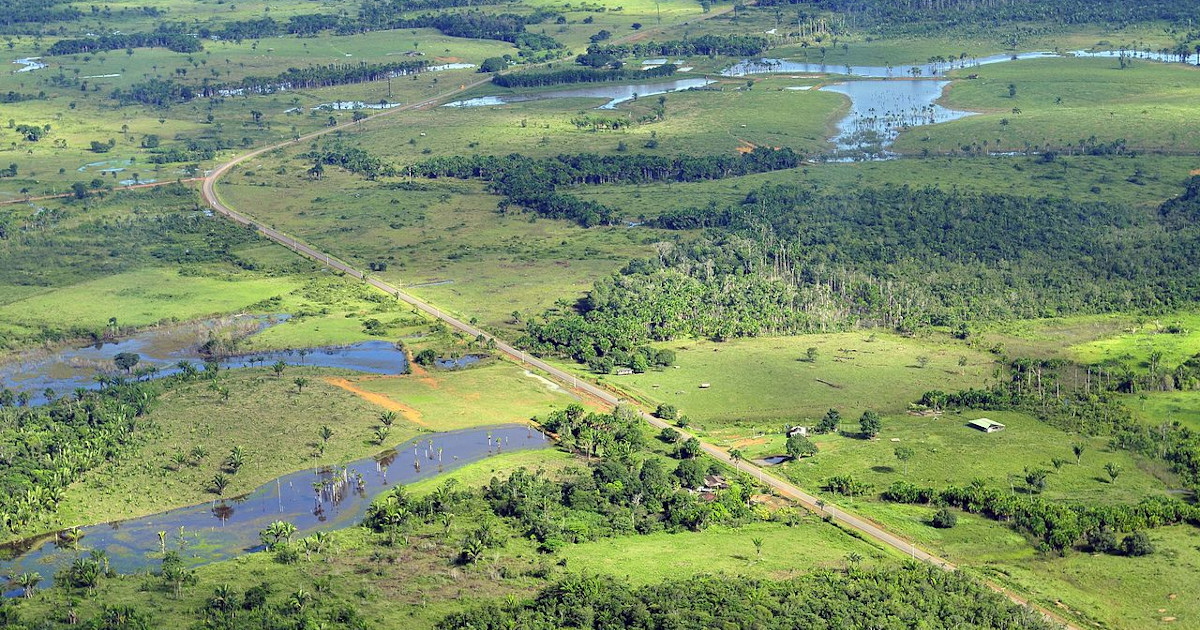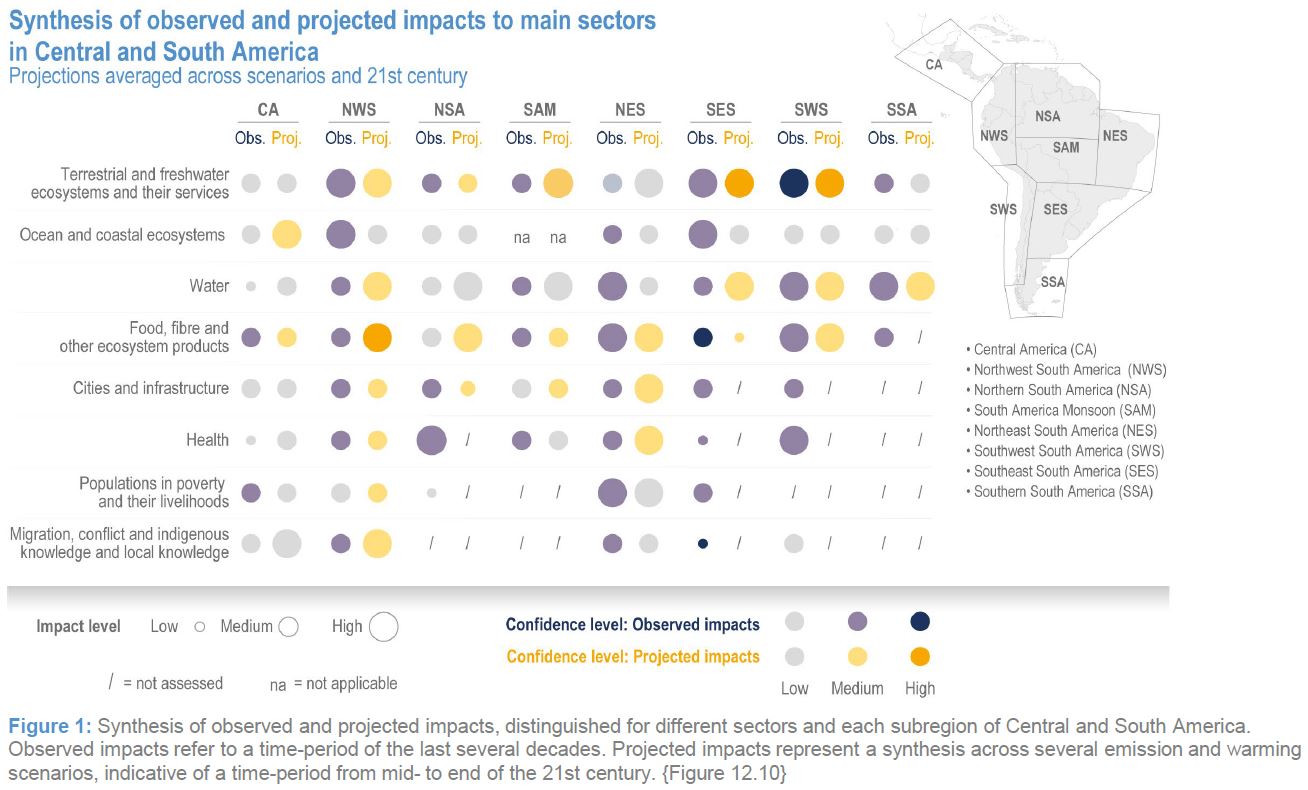IPCC: The impacts of climate change on Central and South America

Deforestation in the Amazon, Manaus area, Brazil
Central and South America are highly vulnerable and have already been severely affected by climate change. These impacts are exacerbated by inequalities, poverty, population growht and density, land use practices, and especially deforestation, which leads to biodiversity loss and soil degradation. This situation makes local and national economies even more dependent on dwindling natural resources for the production of essential goods.
Several extreme weather events are already affecting there regions, and projections indicate an increase in such events with higher temperatures, greater aridity, rising sea levels, coastal erosion, ocean and lake acidification, and more frequent and intense droughts that will reduce water availability impairing agricultural productivity, traditional fishing activities, food security, and human health.
Ecosystems
The oceanic and coastal ecosystems in the region, such as coral reefs, estuaries, salt marshes, mangroves, and sandy shores, are highly susceptible to climate change. Projections show that coral reefs will lose their habitat, alter their distribution ranges, and will suffer from bleaching due to ocean warming. The distribution of terrestrial species has already shifted in the Andes due to higher temperatures. Up to 85% of natural systems (animal and plant species, habitats and ecological communities) in the region’s biodiversity hotspots could be affected by climate change.
The Amazon forest, one of the largest biodiversity reserves in the world, is becoming increasingly vulnerable due to drought. High temperatures and droughts observed in 1998, 2005, and 2016 (unprecedented and attributed to climate change) have already negatively impacted the forest ecosystem. This, combined with anthropogenic land use, could further increase the vulnerability of terrestrial ecosystems to extreme weather events and to wildfires.
Cities and settlements
Urban areas in the region are vulnerable for several reasons, primarily due to the high poverty rates, inadequate and unevenly distributed infrastructure, housing shortages, and the frequent occupation of high-risk areas. Such vulnerability conditions are further exacerbated by unstable political and governmental institutions, susceptibility to corruption, and limited financial capacity. The region also frequently reports climate change impacts on water availability in urban areas, on drainage systems, and sewage infrastructure.
Water
Glacier retreat, rising temperatures, precipitation variability, land use, landslides, and floodings have impacted ecosystems, water resources, and livelihoods. Projections indicate increased water scarcity and competition for water resources. These disruptions will further degrade ecosystems such as wetlands and agricultural communities, public health and energy production, especially in areas heavily reliant on hydropower.
Food and agriculture
Since the mid-20th century, increased precipitation has positively affected agricultural production in South America. However, prolonged and harsh dry seasons have become more frequent, hitting the economy and cities in south-eastern Brazil.
On the other hand, reduced rainfall and altered rainy seasons in Central America (the so-called dry corridor: Honduras, Guatemala, El Salvador) and the tropical Andes have had severe consequences on agriculture and food security. This is especially true for medium-sized farms and indigenous mountain populations, whose conditions are expected to worsen.
Migrations
The Andes, north-eastern Brazil, and northern countries of Central America are among the regions most susceptible to climate migrations. In these areas, climatic factors like droughts, tropical storms, hurricanes, and floods combine with social, political, and geopolitical factors.
Health
Climate change affects the epidemiology of infectious diseases that depend on climatic factors. Examples include the effects of high temperatures on the transmissibility of endemic and emerging vector-borne diseases such as dengue, chikungunya and Zika. These and other diseases are projected to increase in the coming decades.

AR6 WG2 IPCC, Fact sheet Centro e Sud America, figura 1
Options for adaptation
Policies and actions at various levels, as well as the participation of actors from all societal groups, including the most vulnerable, are crucial for effective adaptation. Approaches integrating indigenous and local knowledge with natural and social sciences have grown since 2014 and are helping improve decision-making processes in this region, promoting the adaptation of ecosystems and communities.
Initiatives to improve informal settlements and ensure access to land and decent housing are in line with adaptation policies aiming at alleviating poverty, inequalities, and disaster risk exposure.
Obstacles to adaptation
The main obstacles to adaptation in terrestrial, riverine, oceanic, and coastal ecosystems are financial in nature. These challenges are compounded by institutional instability, fragmented services, inadequate management of water resources, inadequate governance structures, and insufficient data analysis. Additionally, there is a need to fill gaps in adaptation capacity and the institutional ability to implement adaptation measures.
This article was translated into English by Sofia Belardinelli. The original version of this article is available here.
ALSO READ:
- IPCC: Nearly direct correlation between emissions and global warming
- IPCC: Impacts of climate change are not equal for everyone
- IPCC: The impacts of climate change on Africa
- IPCC: The impacts of climate change on Europe
- IPCC: The impact of climate change on small islands
- IPCC: The impacts of climate change on Asia
- IPCC: The impacts of climate change on Oceania
- IPCC: The impacts of climate change on Central and South America
- IPCC: The impacts of climate change on North America
- IPCC: The impacts of climate change on human settlements
- IPCC Synthesis Report: every fraction of a degree matters









